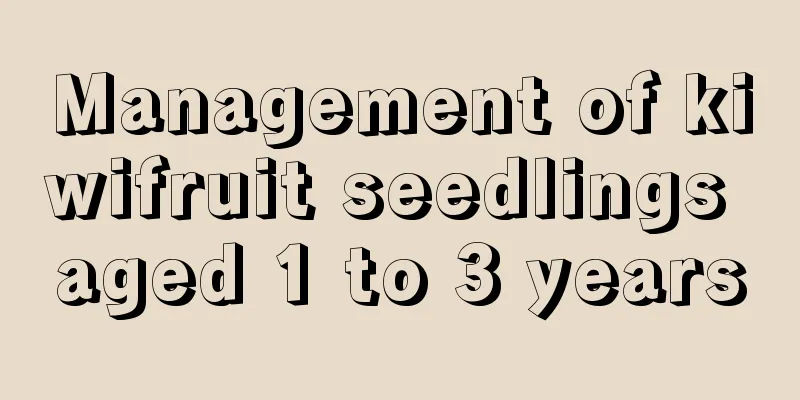Management of kiwifruit seedlings aged 1 to 3 years

|
The economic life of kiwifruit is as long as several decades. Shaping management during the initial planting is critical. The quality of shaping directly affects the growth results in the following years and has a great impact on the yield. Here we talk about the management of kiwifruit seedlings for 1 to 3 years. 1. Plastic surgery The tree is shaped according to the pinnate shape of "one main trunk, two main vines, and the fruiting mother branches are directly attached to the main vines". Keep a distance of 30 cm between the fruiting mother branches on both sides of the main vine. When cultivating the main trunk and main vines, try to allow them to grow enough at one time, keep the main trunk and main vines straight, and avoid multiple pruning. Note during plastic surgery: 1. Choose two-year-old seedlings to build the garden. After planting, the weak seedlings that cannot be grafted will be cut flat with 3 to 5 buds left; at the same time, the selected scion varieties will be stored at 4°C for winter. 2. When there are few sprouts, you should spray or apply bud-starting agent on the middle and rear part of the main vine in February in advance to increase the germination rate; or when the spring shoots grow to early to mid-May, apply branch-stimulating agent to the buds in the appropriate position in the middle and rear part of the main vine to promote their emergence. 3. When establishing a garden with seedlings, thicker seedlings should be grafted just as they are about to enter the wound flow period. The best grafting site is one with a better degree of lignification and a diameter of more than 0.7 cm. When the scion sprouts, apply a brush on its top growth point to enhance its growth potential. 4. When cultivating the main trunk, erect bamboo poles next to the seedlings in spring, or pull iron wires on the poles, and hang wires on the iron wires to prepare for straightening the seedlings. 2. Root Care Adhere to the principles of light pruning, leaving more branches, and thinning buds to improve the root-crown ratio. During the sapling stage, after cultivating the tree shape according to the standard and setting up the backbone framework at all levels, we should pay attention to retaining (more) branches and leaves, alleviating the vigorous growth, cultivating moderate tree vigor, promoting the return of organic nutrients to the roots, promoting root development, and increasing the root-crown ratio, laying a good foundation for high, stable and high-quality yields. 3. Main vine cultivation When the main trunk is longer than the frame surface, it can be cut off 30 to 40 centimeters away from the frame surface, and then the two buds sprouting at the top can be selected as the main vines for cultivation. After the two main vine buds at the top begin to sprout, pay attention to tying and supporting them to avoid breaking them. 4. Fertilization The more growth a fruit tree completes in a year, the more nutrients it needs. Be sure to pay attention to the addition of fertilizer , in small amounts and multiple times. In spring and summer, you can use compound fertilizers with high nitrogen content. In autumn, you should pay attention to using compound fertilizers with high phosphorus and potassium content to promote the aging of the main vines and branches of fruit trees to ensure their safe wintering. 5. Fruiting mother branch cultivation When the main vine is cultivated, cut it off from the place where the growth is obviously weak during the winter pruning. After germination in the spring of the following year, start cultivating the fruiting mother branches, leaving a bud at intervals of about 30 cm. The empty spaces can be filled after the latent buds germinate. Be careful to remove buds that are too crowded. If the nutrient accumulation in the previous year is relatively sufficient, flower buds will generally appear on the main vine. At this time, you must not be greedy and leave too many fruits. Just leave a few trial fruits on each tree and a few fruits close to the main trunk to balance the tree's vigor. That’s it |
>>: When should sweet potatoes be planted and seedlings started?
Recommend
Three Plants with Soil Repair Capabilities
willow Jade is made up into a tall tree, with tho...
Why doesn't Monstera bloom?
1. Not enough years Monstera can bloom, but it is...
Time and method of changing soil in jade tree
Time to change the soil in Yushu The soil of jade...
How to prune orchids?
Orchid pruning time There is no fixed time for pr...
These flowers will survive with just a little water! It’s no hassle at all! Why don't you raise it quickly?
Hoya Hydroponic method: Select healthy branches, ...
How to prune windmill jasmine
How to prune the branches of windmill jasmine Pru...
Do hydrangeas like sunlight or shade?
Introduction to Hydrangea Common varieties of hyd...
How to grow the succulent plant red curly
How to choose red silk When purchasing potted red...
Learn these secret flower-growing techniques now!
Azalea (Author: Yasu Anqi Source: POPO Photograph...
When is the best time to sow vinca seeds?
Vinca roseus seed sowing time Catharanthus roseus...
The growing environment and local conditions of mango trees
Mango Tree Growth Environment and Conditions Mang...
How to grow baby's breath in winter
Gypsophila paniculata is popular for its charming...
The difference between Shiratori and Ji Chunxing, remember two points to distinguish them!
Appearance characteristics White bird appearance ...
When is the best time to sow camphor?
Camphor tree planting time Fragrant camphor belon...
The breeding method of Anping's ten great fruits
1. Soil It is a broad-leaved plant that likes moi...









